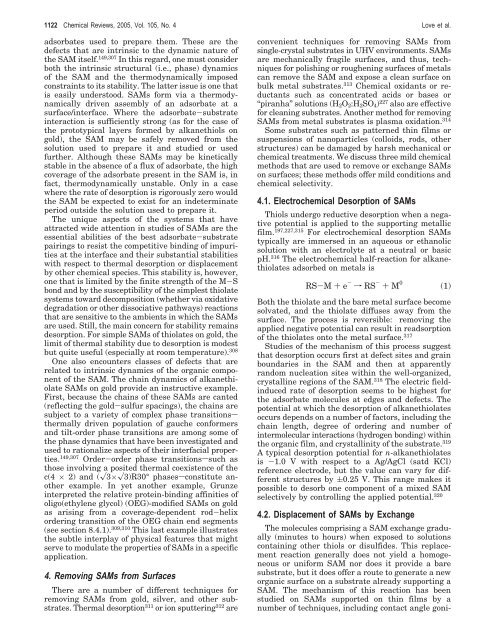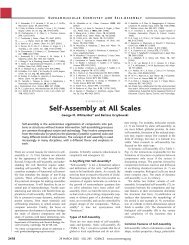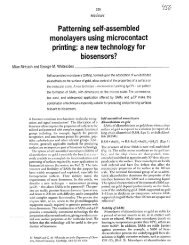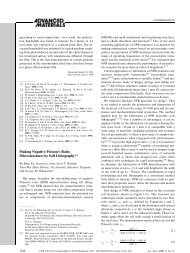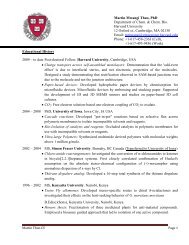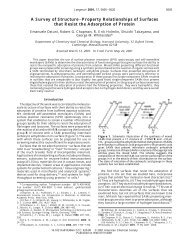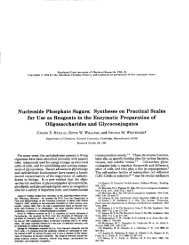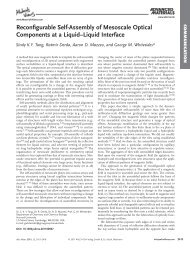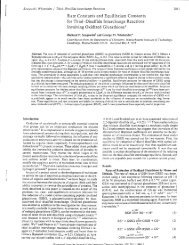Self-Assembled Monolayers of Thiolates on Metals as - Whitesides ...
Self-Assembled Monolayers of Thiolates on Metals as - Whitesides ...
Self-Assembled Monolayers of Thiolates on Metals as - Whitesides ...
You also want an ePaper? Increase the reach of your titles
YUMPU automatically turns print PDFs into web optimized ePapers that Google loves.
1122 Chemical Reviews, 2005, Vol. 105, No. 4 Love et al.<br />
adsorbates used to prepare them. These are the<br />
defects that are intrinsic to the dynamic nature <str<strong>on</strong>g>of</str<strong>on</strong>g><br />
the SAM itself. 149,307 In this regard, <strong>on</strong>e must c<strong>on</strong>sider<br />
both the intrinsic structural (i.e., ph<strong>as</strong>e) dynamics<br />
<str<strong>on</strong>g>of</str<strong>on</strong>g> the SAM and the thermodynamically imposed<br />
c<strong>on</strong>straints to its stability. The latter issue is <strong>on</strong>e that<br />
is e<strong>as</strong>ily understood. SAMs form via a thermodynamically<br />
driven <strong>as</strong>sembly <str<strong>on</strong>g>of</str<strong>on</strong>g> an adsorbate at a<br />
surface/interface. Where the adsorbate-substrate<br />
interacti<strong>on</strong> is sufficiently str<strong>on</strong>g (<strong>as</strong> for the c<strong>as</strong>e <str<strong>on</strong>g>of</str<strong>on</strong>g><br />
the prototypical layers formed by alkanethiols <strong>on</strong><br />
gold), the SAM may be safely removed from the<br />
soluti<strong>on</strong> used to prepare it and studied or used<br />
further. Although these SAMs may be kinetically<br />
stable in the absence <str<strong>on</strong>g>of</str<strong>on</strong>g> a flux <str<strong>on</strong>g>of</str<strong>on</strong>g> adsorbate, the high<br />
coverage <str<strong>on</strong>g>of</str<strong>on</strong>g> the adsorbate present in the SAM is, in<br />
fact, thermodynamically unstable. Only in a c<strong>as</strong>e<br />
where the rate <str<strong>on</strong>g>of</str<strong>on</strong>g> desorpti<strong>on</strong> is rigorously zero would<br />
the SAM be expected to exist for an indeterminate<br />
period outside the soluti<strong>on</strong> used to prepare it.<br />
The unique <strong>as</strong>pects <str<strong>on</strong>g>of</str<strong>on</strong>g> the systems that have<br />
attracted wide attenti<strong>on</strong> in studies <str<strong>on</strong>g>of</str<strong>on</strong>g> SAMs are the<br />
essential abilities <str<strong>on</strong>g>of</str<strong>on</strong>g> the best adsorbate-substrate<br />
pairings to resist the competitive binding <str<strong>on</strong>g>of</str<strong>on</strong>g> impurities<br />
at the interface and their substantial stabilities<br />
with respect to thermal desorpti<strong>on</strong> or displacement<br />
by other chemical species. This stability is, however,<br />
<strong>on</strong>e that is limited by the finite strength <str<strong>on</strong>g>of</str<strong>on</strong>g> the M-S<br />
b<strong>on</strong>d and by the susceptibility <str<strong>on</strong>g>of</str<strong>on</strong>g> the simplest thiolate<br />
systems toward decompositi<strong>on</strong> (whether via oxidative<br />
degradati<strong>on</strong> or other dissociative pathways) reacti<strong>on</strong>s<br />
that are sensitive to the ambients in which the SAMs<br />
are used. Still, the main c<strong>on</strong>cern for stability remains<br />
desorpti<strong>on</strong>. For simple SAMs <str<strong>on</strong>g>of</str<strong>on</strong>g> thiolates <strong>on</strong> gold, the<br />
limit <str<strong>on</strong>g>of</str<strong>on</strong>g> thermal stability due to desorpti<strong>on</strong> is modest<br />
but quite useful (especially at room temperature). 308<br />
One also encounters cl<strong>as</strong>ses <str<strong>on</strong>g>of</str<strong>on</strong>g> defects that are<br />
related to intrinsic dynamics <str<strong>on</strong>g>of</str<strong>on</strong>g> the organic comp<strong>on</strong>ent<br />
<str<strong>on</strong>g>of</str<strong>on</strong>g> the SAM. The chain dynamics <str<strong>on</strong>g>of</str<strong>on</strong>g> alkanethiolate<br />
SAMs <strong>on</strong> gold provide an instructive example.<br />
First, because the chains <str<strong>on</strong>g>of</str<strong>on</strong>g> these SAMs are canted<br />
(reflecting the gold-sulfur spacings), the chains are<br />
subject to a variety <str<strong>on</strong>g>of</str<strong>on</strong>g> complex ph<strong>as</strong>e transiti<strong>on</strong>ss<br />
thermally driven populati<strong>on</strong> <str<strong>on</strong>g>of</str<strong>on</strong>g> gauche c<strong>on</strong>formers<br />
and tilt-order ph<strong>as</strong>e transiti<strong>on</strong>s are am<strong>on</strong>g some <str<strong>on</strong>g>of</str<strong>on</strong>g><br />
the ph<strong>as</strong>e dynamics that have been investigated and<br />
used to rati<strong>on</strong>alize <strong>as</strong>pects <str<strong>on</strong>g>of</str<strong>on</strong>g> their interfacial properties.<br />
149,307 Order-order ph<strong>as</strong>e transiti<strong>on</strong>sssuch <strong>as</strong><br />
those involving a posited thermal coexistence <str<strong>on</strong>g>of</str<strong>on</strong>g> the<br />
c(4 × 2) and (�3×�3)R30° ph<strong>as</strong>essc<strong>on</strong>stitute another<br />
example. In yet another example, Grunze<br />
interpreted the relative protein-binding affinities <str<strong>on</strong>g>of</str<strong>on</strong>g><br />
oligo(ethylene glycol) (OEG)-modified SAMs <strong>on</strong> gold<br />
<strong>as</strong> arising from a coverage-dependent rod-helix<br />
ordering transiti<strong>on</strong> <str<strong>on</strong>g>of</str<strong>on</strong>g> the OEG chain end segments<br />
(see secti<strong>on</strong> 8.4.1). 309,310 This l<strong>as</strong>t example illustrates<br />
the subtle interplay <str<strong>on</strong>g>of</str<strong>on</strong>g> physical features that might<br />
serve to modulate the properties <str<strong>on</strong>g>of</str<strong>on</strong>g> SAMs in a specific<br />
applicati<strong>on</strong>.<br />
4. Removing SAMs from Surfaces<br />
There are a number <str<strong>on</strong>g>of</str<strong>on</strong>g> different techniques for<br />
removing SAMs from gold, silver, and other substrates.<br />
Thermal desorpti<strong>on</strong> 311 or i<strong>on</strong> sputtering 312 are<br />
c<strong>on</strong>venient techniques for removing SAMs from<br />
single-crystal substrates in UHV envir<strong>on</strong>ments. SAMs<br />
are mechanically fragile surfaces, and thus, techniques<br />
for polishing or roughening surfaces <str<strong>on</strong>g>of</str<strong>on</strong>g> metals<br />
can remove the SAM and expose a clean surface <strong>on</strong><br />
bulk metal substrates. 313 Chemical oxidants or reductants<br />
such <strong>as</strong> c<strong>on</strong>centrated acids or b<strong>as</strong>es or<br />
“piranha” soluti<strong>on</strong>s (H2O2:H2SO4) 227 also are effective<br />
for cleaning substrates. Another method for removing<br />
SAMs from metal substrates is pl<strong>as</strong>ma oxidati<strong>on</strong>. 314<br />
Some substrates such <strong>as</strong> patterned thin films or<br />
suspensi<strong>on</strong>s <str<strong>on</strong>g>of</str<strong>on</strong>g> nanoparticles (colloids, rods, other<br />
structures) can be damaged by harsh mechanical or<br />
chemical treatments. We discuss three mild chemical<br />
methods that are used to remove or exchange SAMs<br />
<strong>on</strong> surfaces; these methods <str<strong>on</strong>g>of</str<strong>on</strong>g>fer mild c<strong>on</strong>diti<strong>on</strong>s and<br />
chemical selectivity.<br />
4.1. Electrochemical Desorpti<strong>on</strong> <str<strong>on</strong>g>of</str<strong>on</strong>g> SAMs<br />
Thiols undergo reductive desorpti<strong>on</strong> when a negative<br />
potential is applied to the supporting metallic<br />
film. 197,227,315 For electrochemical desorpti<strong>on</strong> SAMs<br />
typically are immersed in an aqueous or ethanolic<br />
soluti<strong>on</strong> with an electrolyte at a neutral or b<strong>as</strong>ic<br />
pH. 316 The electrochemical half-reacti<strong>on</strong> for alkanethiolates<br />
adsorbed <strong>on</strong> metals is<br />
RS-M + e - f RS - + M 0<br />
(1)<br />
Both the thiolate and the bare metal surface become<br />
solvated, and the thiolate diffuses away from the<br />
surface. The process is reversible: removing the<br />
applied negative potential can result in readsorpti<strong>on</strong><br />
<str<strong>on</strong>g>of</str<strong>on</strong>g> the thiolates <strong>on</strong>to the metal surface. 317<br />
Studies <str<strong>on</strong>g>of</str<strong>on</strong>g> the mechanism <str<strong>on</strong>g>of</str<strong>on</strong>g> this process suggest<br />
that desorpti<strong>on</strong> occurs first at defect sites and grain<br />
boundaries in the SAM and then at apparently<br />
random nucleati<strong>on</strong> sites within the well-organized,<br />
crystalline regi<strong>on</strong>s <str<strong>on</strong>g>of</str<strong>on</strong>g> the SAM. 318 The electric fieldinduced<br />
rate <str<strong>on</strong>g>of</str<strong>on</strong>g> desorpti<strong>on</strong> seems to be highest for<br />
the adsorbate molecules at edges and defects. The<br />
potential at which the desorpti<strong>on</strong> <str<strong>on</strong>g>of</str<strong>on</strong>g> alkanethiolates<br />
occurs depends <strong>on</strong> a number <str<strong>on</strong>g>of</str<strong>on</strong>g> factors, including the<br />
chain length, degree <str<strong>on</strong>g>of</str<strong>on</strong>g> ordering and number <str<strong>on</strong>g>of</str<strong>on</strong>g><br />
intermolecular interacti<strong>on</strong>s (hydrogen b<strong>on</strong>ding) within<br />
the organic film, and crystallinity <str<strong>on</strong>g>of</str<strong>on</strong>g> the substrate. 319<br />
A typical desorpti<strong>on</strong> potential for n-alkanethiolates<br />
is -1.0 V with respect to a Ag/AgCl (satd KCl)<br />
reference electrode, but the value can vary for different<br />
structures by (0.25 V. This range makes it<br />
possible to desorb <strong>on</strong>e comp<strong>on</strong>ent <str<strong>on</strong>g>of</str<strong>on</strong>g> a mixed SAM<br />
selectively by c<strong>on</strong>trolling the applied potential. 320<br />
4.2. Displacement <str<strong>on</strong>g>of</str<strong>on</strong>g> SAMs by Exchange<br />
The molecules comprising a SAM exchange gradually<br />
(minutes to hours) when exposed to soluti<strong>on</strong>s<br />
c<strong>on</strong>taining other thiols or disulfides. This replacement<br />
reacti<strong>on</strong> generally does not yield a homogeneous<br />
or uniform SAM nor does it provide a bare<br />
substrate, but it does <str<strong>on</strong>g>of</str<strong>on</strong>g>fer a route to generate a new<br />
organic surface <strong>on</strong> a substrate already supporting a<br />
SAM. The mechanism <str<strong>on</strong>g>of</str<strong>on</strong>g> this reacti<strong>on</strong> h<strong>as</strong> been<br />
studied <strong>on</strong> SAMs supported <strong>on</strong> thin films by a<br />
number <str<strong>on</strong>g>of</str<strong>on</strong>g> techniques, including c<strong>on</strong>tact angle g<strong>on</strong>i-


